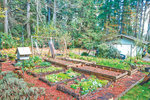

For residents of the PNW, the transition between hot and windbreaker weather is as welcome as the resurrection of pumpkin spice lattes. To gardeners, the shift in season is a signal that we’re running out of time. While the days of rest and reflection are near, fall is a frantic fluster, with attention oscillating between wishing the zucchini would give up already and trying to coach the tomatoes into turning red before a frost.
Long before the zucchini blossomed, I was working on the next iteration of my spring garden. As soon as I’m ready to pile the lagging tomatoes onto a windowsill to cross the finish line into flavor town, much of my garden will be disassembled and rebuilt before being officially tucked in for winter.
Traditionally, putting gardens “to bed” for winter includes pulling dead vegetation, planting bulbs, and adding a layer of mulch to protect the soil. This process is basically what I intend to do, however, I have been eager to redo some garden beds (or as I like to call them, slug hotels) that I had built from recycled pallets and weaved from foraged sticks. The task of removing them wouldn’t be so urgent if not for the fact that I practice no-till gardening and have a lot of garlic to get in the ground before the end of fall.
No-till, or no-dig, gardening is where instead of rototilling your garden space each season, you just keep layering compost and mulch on each bed or row, increasing the organic matter, suppressing weeds, and leaving the microorganisms, worms and fungal networks in the soil undisturbed.
The no-till method was spearheaded by market gardener Charles Dowding and through continuous trials he has been able to show a significant difference in vegetable growth between beds that are broken up with a broad fork and beds that are only layered with finished compost. I was an immediate adoptee of this method for many reasons, none of which having to do with the fact that I couldn’t push our rototiller.
My own variation of no-dig is not as refined, though. While Dowding uses a beautiful, finished compost, I take all the dying vegetation that’s currently in the garden as well as the contents of my compost tower (essentially what’s been collected since last winter) and chuck them on the beds as is.
The debris and unfinished compost are mixed with some aged leaves on top of the bed to ensure the carbon/nitrogen ratios are somewhat balanced, and then I cover that layer with soiled straw from the chicken coop. This process is also known as the lasagna method and the layers are left to decompose at their leisure. Come spring, if the materials are still breaking down, I add a few inches of soil on the top, either sifted from the chicken coop or from a bagged organic garden mix, a few weeks before I’m ready to plant.
The no-dig prep is something I could wait until spring to do (if my compost was managed in a flawless manner), but planting my garlic is not. Garlic needs a certain number of cold hours before it will produce a bulb. Where my garlic is planted in fall determines the fate of the garden for the next season. And this year I’m doubling production so I can’t mess around.
Garlic, in my house, is as necessary as toilet paper; we’d get pretty cranky if we ran out. I’ve grown a rocambole hardneck variety that produces a curly scape and large cloves in past seasons that has done fantastic in the cold and wet. This year I am adding a few new varieties of hardneck and one variety of softneck.
I highly recommend adding garlic to your rotation this season if you haven’t already, especially if your garden is like mine; in the woods and getting only four to six hours of sun max. While I’ve found most crops will grow and produce OK with this amount of sun exposure, garlic has consistently been my No. 1 performing staple.
Unfortunately, garlic is about the extent of my winter garden cultivations. Come November, the sun barely peeks through the trees, leaving the growing space completely shaded. Curating a hardy selection of greens under cloches and cold frames is therefore not a realistic option for me. Though, needless to say, if I was blessed with wide open spaces and a low but bright burning sun, you could bet my growing season would never end.
For gardens with an unadulterated southern exposure that is consistently graced by the touch of sunlight, a winter crop is totally possible, and you should absolutely be taking advantage of it. Kale, lettuce, radishes, beets, bok choy, and spinach are just a few things that you can get going in the low temperatures of fall and, albeit slowly, straight into winter.
UNDERWRITTEN BY THE FUND FOR NONPROFIT NEWS (NEWSMATCH) AT THE MIAMI FOUNDATION, THE ANGEL GUILD, ADVERTISERS, DONORS AND PEOPLE WHO SUPPORT INDEPENDENT, NONPROFIT LOCAL NEWS